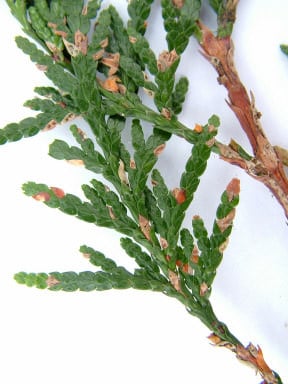
Quick facts
Common name - Thuja blight, needle blight, needle scorch, ‘Keithia’ disease
Scientific name - Didymascella thujina (syn. Keithia thujina)
Plants affected - Thuja, particularly T. plicata
Main symptoms - Dead scale leaves containing oval, dark brown to black fungal fruiting bodies, which fall out to leave a cavity
Caused by - Fungus
Timing - Late spring/summer
What is Thuja blight?
Thuja blight is a fungal disease caused by Didymascella thujina (syn. Keithia thujina) that attacks the leaves and shoots of Thuja species, particularly Western red cedar (Thuja plicata). Young trees can be badly damaged, and the disease can also be unsightly on larger specimens. Lower branches tend to be worst affected, particularly in dense plantings with poor air circulation.
Symptoms
You may see the following symptoms:
- Individual scale leaves turn yellowish and then brown in late spring and early summer
- Large, oval, brown-black fungal fruiting bodies, visible to the naked eye, develop in the leaf. There is usually one fruiting body per scale leaf, but sometimes two or three
- The fruiting bodies fall out once they have released their spores, leaving a cavity in the leaf (which could be mistaken for pest damage)
- Dead leaves can persist on the tree throughout the winter
- Heavy infections can lead to widespread browning of leaves, and sometimes twig dieback. Seedlings and young plants (up to four or five years old) can be killed
Control
The RHS believes that avoiding pests, diseases and weeds by good practice in cultivation methods, cultivar selection, garden hygiene and encouraging or introducing natural enemies, should be the first line of control. If chemical controls are used, they should be used only in a minimal and highly targeted manner.
Non-chemical control
- Avoid planting Thuja plicata (particularly seedlings and young plants) in areas where air circulation is poor
- Remove and dispose of any twigs that are shed as a result of infection by Thuja blight
- Cut out heavily-infected shoots, if this can be done without spoiling the overall shape of the tree
Fungicides
The RHS recommends that you don't use fungicides. Fungicides (including organic types) may reduce biodiversity, impact soil health and have wider adverse environmental effects. If you do intend to use a fungicide, please read the information given in the link and download below to ensure that use, storage and disposal of the product is done in a responsible and legally compliant manner.
The products listed in the ‘Fungicides for gardeners’ document below are legally available for use by home gardeners in the UK. This information is provided to avoid misuse of legal products and the use of unauthorised and untested products, which potentially has more serious consequences for the environment and wildlife than when products are used legally. Homemade products are not recommended as they are unregulated and usually untested.
There is no specific information available as to the efficacy of any home garden fungicide against Thuja blight.
Download
Fungicides for gardeners (Adobe Acrobat pdf document outlining fungicides available to gardeners)
Link
Biology
Infection is favoured by leaf wetness so on larger trees the lower branches, where air circulation is poorer, tend to be the worst affected. On smaller, younger trees the entire plant can be affected, particularly in dense plantings.
The black fruiting bodies develop just below the leaf surface, and when they are mature the epidermis of the leaf splits open and spores are released. The spores are produced from May to October. They are resistant to desiccation, and spores shed in the autumn can overwinter on the leaf surface to germinate the following spring.




